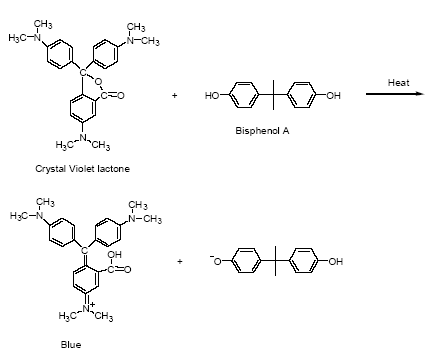|
| Front page | | Contents | | Previous | | Next |
Evaluation of Alternatives for Compounds under Risk Assessment in the EU, Bisphenol A
5 Thermographic printing
In thermographic printing, heat is used to develop an image on a substrate, usually paper. Either an image forming material (thermoplastic ink) is heated and transferred to the substrate,
the "thermal ink transfer printing", or the substrate is coated with an image forming material, which can be developed by applying heat during printing, the "direct thermal transfer printing"
(Ullmann, 2002).
Thermal ribbons and resistive ribbons can be used for "thermal ink transfer printing" but neither of these ribbons contain bisphenol A.
In "direct thermal transfer printing", heat generated in a thermal head causes a heat sensitive material on the paper to react, forming a coloured image. This paper is referred to as thermal
paper and may contain bisphenol A. In the EU, e.g. in Austria, the main source of bisphenol A released to the environment is believed to be the recycling of thermal paper (Leisewitz &
Schwartz, 1997; EU 2002). In the process of recycling, the waste paper is often bleached with sodium hypochlorite and chlorinated derivatives may be formed. In a study of waste
water from twenty Japanese paper recycling plants, 3,3'-dichlorinated bisphenol A derivatives were detected. They were found to be 28 times more estrogenic than the non-chlorinated
bisphenol A (Fukazawa et al., 2002).
Thermal paper consists of a smooth base paper with a 5-10 m coating. The coating contains a leuco dye and a phenol developer (e.g. bisphenol A) as well as a binder (e.g. styrene,
maleic anhydride copolymer) and other substances. The developer and the leuco dye react to the heat application causing the visible colour to be formed (Figure 5.1).

Figure 5.1 The reaction process between the leuco dye and the phenol developer
Both the developed areas and the non-developed areas of the thermal paper will contain bisphenol A, which may ultimately be released if e.g. the paper is recycled. The total amount of
BPA used for thermal paper production within the EU is estimated to of 1,400 tonnes/year. The total amount of BPA-containing thermal paper manufactured in the EU is 105,000
tonnes/year (EU, 2003A).
"Direct thermal transfer printing" is used when low resolution and relatively low permanence are acceptable. Popular uses are airline, event and cinema tickets, online lottery and gaming
tickets, labels, point of sale applications, computer printers and charting devices such as portable typewriters, diagnostic printers and portable data collectors; laptop computers,
desktop calculators and handheld calculators; medical, industrial and testing charting devices and facsimile (Appleton, 2003; Ullmann, 2002).
5.1 Alternatives to BPA in thermal paper
The large producers of thermal paper are Nashua and Appleton in the USA, Kanzaki in Japan and Kohler in Germany (MeadWestvaco, 2003).
Examples of the phenol developers are Nippon Soda and SongWon Industrial. The manufacturer, Nippon Soda, produces bisphenol S to be used as a developer in thermal paper
(Nippon Soda, 2003) but Bisphenol F can be used as a developer in thermal paper as well (SongWon Industrial, 2003).
There are indications that, in Japan, bisphenol A has recently been substituted in thermal paper (MeadWestvaco, 2003). In order to verify this, Kanzaki was contacted but no response
was received from the company (Kanzaki, 2003).
5.1.1 Environmental and health screening of alternatives to bisphenol A in thermal paper
Both bisphenols, S and F are used as phenol developers in thermal paper.
Bisphenols S and F
Only very few data were available on bisphenol F and no data were found on bisphenol S.
Table 5.1 Properties of bisphenol F
| Name |
Bisphenol F |
| Synonym |
Bis(2-Hydroxyphenyl)methane, 97%1
2,2'-methylenebisphenol3
|
| CAS No. |
2467-02-9 |
| Formula |
C13H12O2 |
| Classification |
Not present on the list4
Bisphenol A is on the list4
|
| Ready biodegradability |
Data not available |
| Bioaccumulation |
Log Pow (estimated): 3,063 |
| Ecotoxicity |
Data not available |
| Endocrine disruption |
Not present on the list2
Bisphenol A is on the list2
|
| Acute toxicity |
Data not available |
| Irritation/corrosion |
Data not available |
| Sensitization |
Data not available |
| General toxicity by repeated exposure |
Data not available |
| Carcinogenicity |
Data not available |
| Reproductive toxicity |
Data not available |
| Genotoxicity |
Data not available |
- Chemfinder (2003)
- Danish EPA (2003)
- Epiwin (2003)
- Danish EPA (2002)
Both bisphenols F and S have different structures compared with bisphenol A. However, bisphenol F, which was earlier used as an additive to PVC, has been phased out due to its
toxicological properties, which was considered to be very similar to the properties of bisphenol A (Glud & Marstrand, 2003). In order to concentrate on one substance, the use of
bisphenol F as an additive in PVC was thus phased out. A comparison of the QSAR estimations of bisphenol F and bisphenol A also shows little difference between them. The
calculated acute EC/LC50 values for fish, crustaceans and algae are between 2.6 and 4.0 for bisphenol A and between 3.9 and 11.4 for bisphenol F. On the basis of the available data,
their properties are, however, considered to be similar to those of bisphenol A, and they are thus not considered as alternatives.
| Front page | | Contents | | Previous | | Next | | Top |
Version 1.0 March 2004, © Danish Environmental Protection Agency
|